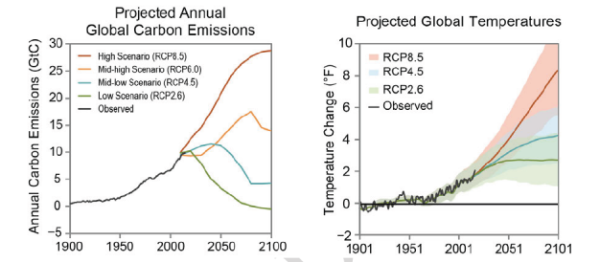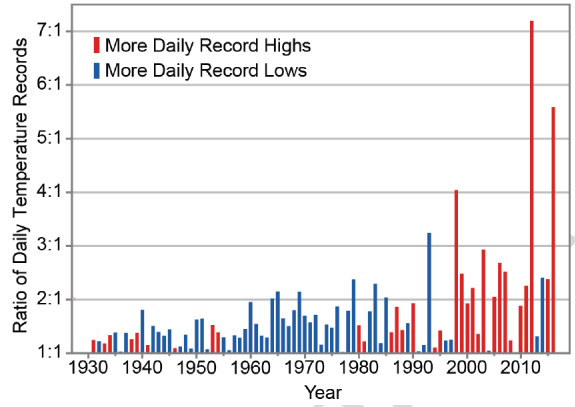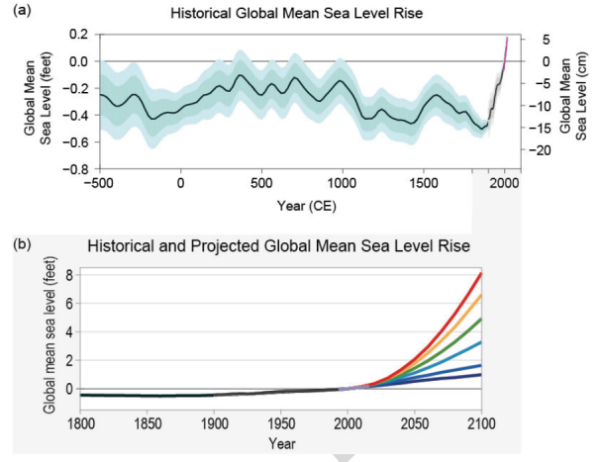Ocean warming and increasing glacial outflows also have a potential to effect ocean overturning circulation in the upper middle latitudes. Of particular interest is the possible disruption of the Atlantic Meridional Overturning Circulation (AMOC) this Century. Recent unconfirmed scientific observation has already pointed to some impacts to AMOC due to warming during recent years. But the report notes that it is presently difficult to validate these observations. Disruption to AMOC would have a considerable impact on North Atlantic weather patterns. It would also reduce both ocean carbon and heat uptake due to a more stratified and less well mixed ocean system. The study identifies a weakening of AMOC of between 12 and 54 percent under worst-case greenhouse gas emissions scenarios.
As risks of ocean stratification mount, acidification of the world’s waters is rapidly increasing. Atmospheric carbon dioxide rising above 400 parts per million was found to worsen detrimental effects by increasing ocean acidity levels.
The study found that the rate of ocean acidification increase was unparalleled in the past 66 million years at least. That higher rates of fossil fuel burning and greenhouse gas emissions would result in another doubling or more of ocean acidity by the end of this Century.
Heating, stratifying, and more acidic oceans are also steadily losing oxygen. The study finds that the amount of oxygen held in the oceans is falling coincident with warming. The study identifies a declining ocean oxygen content at intermediate depths and major losses in oxygen in inland seas, estuaries, along coasts, and in parts of the open ocean. Lower oxygen means more ocean dead zones and more toxic anaerobic microbial blooms. Overall ocean oxygen content is expected to fall by 3.5 percent under worst case warming and fossil fuel emissions scenarios by 2100.
Serious Risk of Unanticipated Changes
The level of evidence provided by the study that humans are changing the climate and that these changes are increasingly harmful is mountainous. And this base fact alone is reason enough for a climate change denying Trump Administration to try and bury its findings. But it is perhaps the study’s own admitted uncertainty over future risks that reveals how reckless Trump’s combined denial of climate change and doubling down on fossil fuel based emissions has ultimately become.
 The study itself is based on physical model and consensus science findings
The study itself is based on physical model and consensus science findings. This lends weight to the evidence it has provided in that it is highly qualified. However, the study responsibly indicates the potential weak points of model based consensus studies. Models are notably less able to duplicate higher paleoclimate levels of warming —
indicating an increased likelihood that rates of warming will be more intense than expected and a reduced likelihood that warming will be less intense than expected. The study also cautions that there is another limitation to the ultimate accuracy of model predictions in that models themselves are unable to capture what it calls
critical threshold and
compound events.
Compound events are described as multiple extreme climate change events occurring at the same time to generate an unanticipated level of harmful disruption. A good example of a compound event is extreme heat risking injury or loss of life, extreme drought harming crops and water supplies in the same region, and both coinciding with a severe or unprecedented wildfire outbreak.
Critical threshold events occur when the climate system crosses a tipping point and then radically adjusts to a new climate state. A worrisome critical threshold event is crossing a tipping point in which significant carbon feedbacks from the Earth System occur — locking in more extreme warming and generating periods in which global temperatures more rapidly spike. Both of these kinds of events have the potential to produce consequences that are difficult or impossible to manage. And
the chance of such catastrophic events occurring increases along with higher rates of fossil fuel burning and coinciding higher levels of warming.
The precautionary principle alone demands that we do our best to avoid increasing these uncertain risks even as we steer away from the much more certain harms like sea level rise and generally increasing extreme weather. The science has again given us a more clear, more refined, gift
in the form of this very valuable provision of foresight. And yet the current U.S. executive leadership is bound and determined to obstinately ignore or it, cast doubt on it, and do everything possible to cloud the clear and priceless message being sent to us by an army of selfless and dedicated climate researchers.








